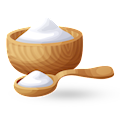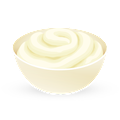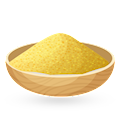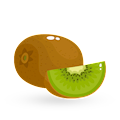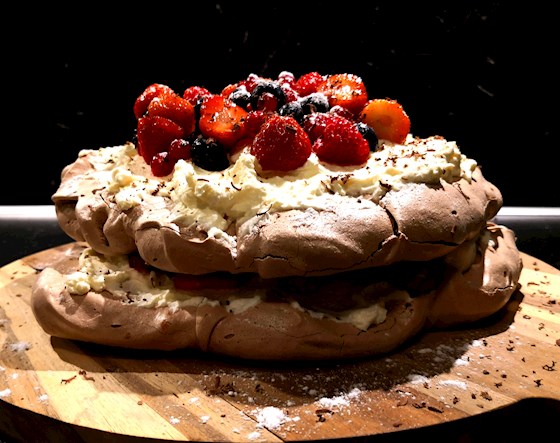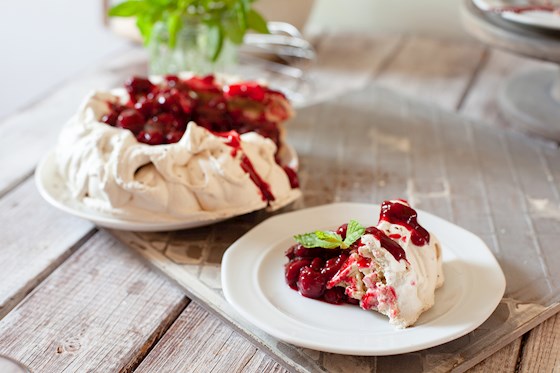Pavlova
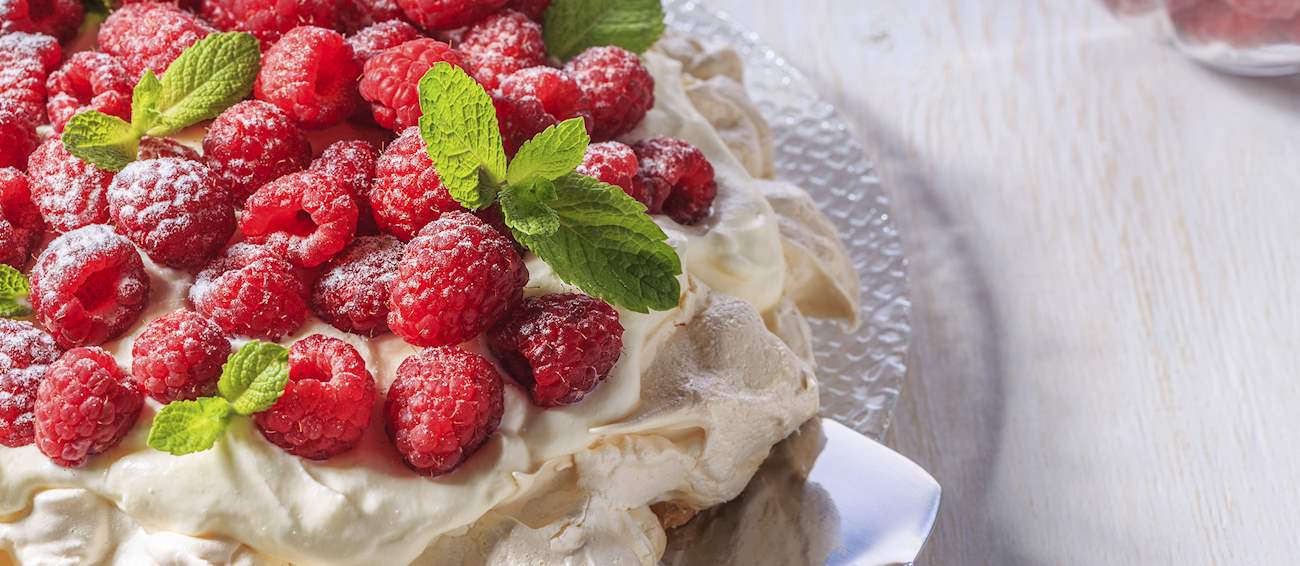
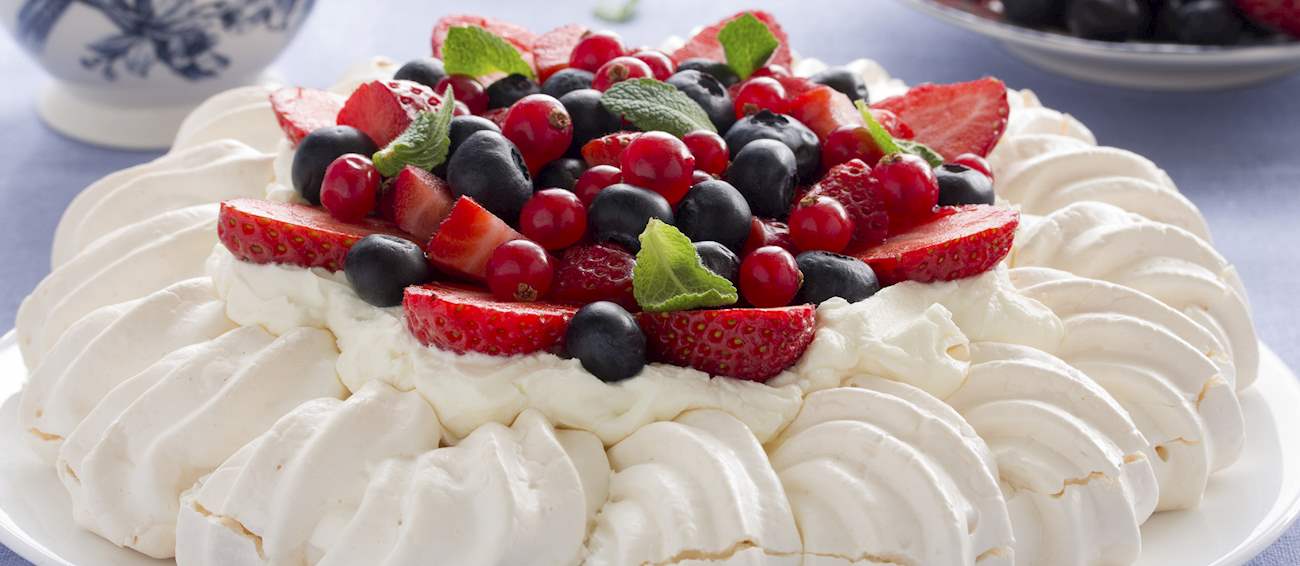
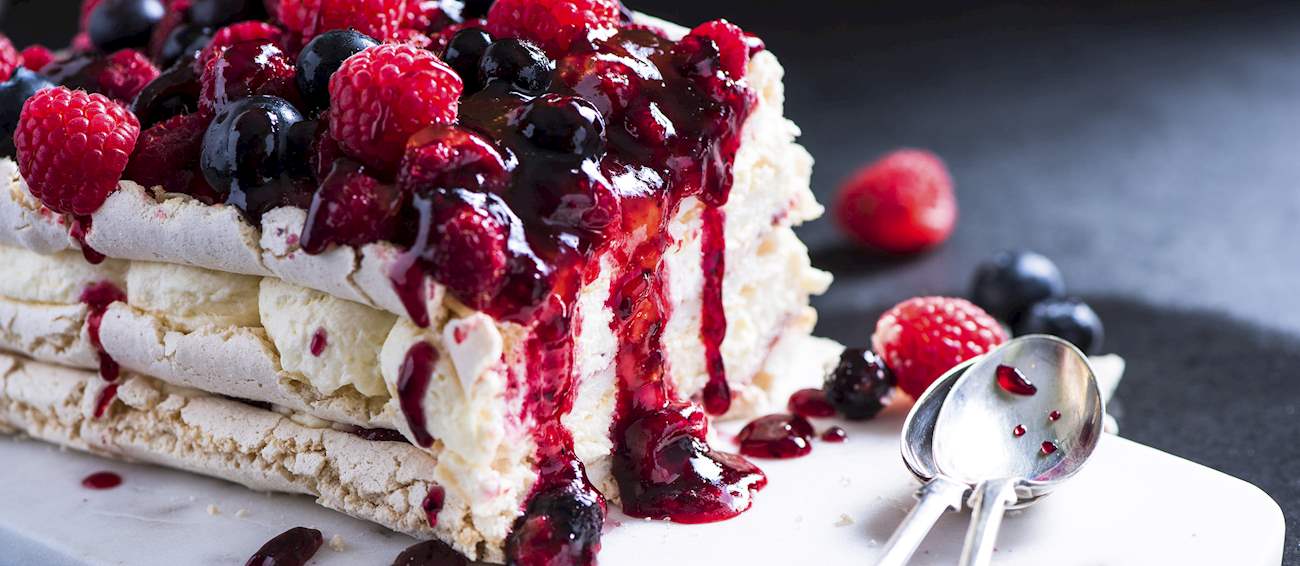


Pavlova
(The Pav)
Delicate as the ballerina it was named after, Pavlova is the quintessential summer dessert. Whipped cream is typically dolloped on top of a snowy meringue, followed by a pop of color in the form of fruit, preferably the tart varieties which contrast the sweetness of the meringue.
Research suggests Pavlova is a descendant of the German torte and was invented in the 1920s during Anna Pavlova's tour of Australia and New Zealand, although the exact inventor is still debated. The first recipe for Pavlova appeared in print in 1926, although it was not the dessert we know today, but was instead a multi-colored gelatine dish.
The base of the cake is prepared almost identically as any meringue, by beating egg whites stiffly, then incorporating sugar, vinegar, and cornstarch. Traditional toppings include whipped cream or lemon curd, and the dessert is often prepared during Christmastime.
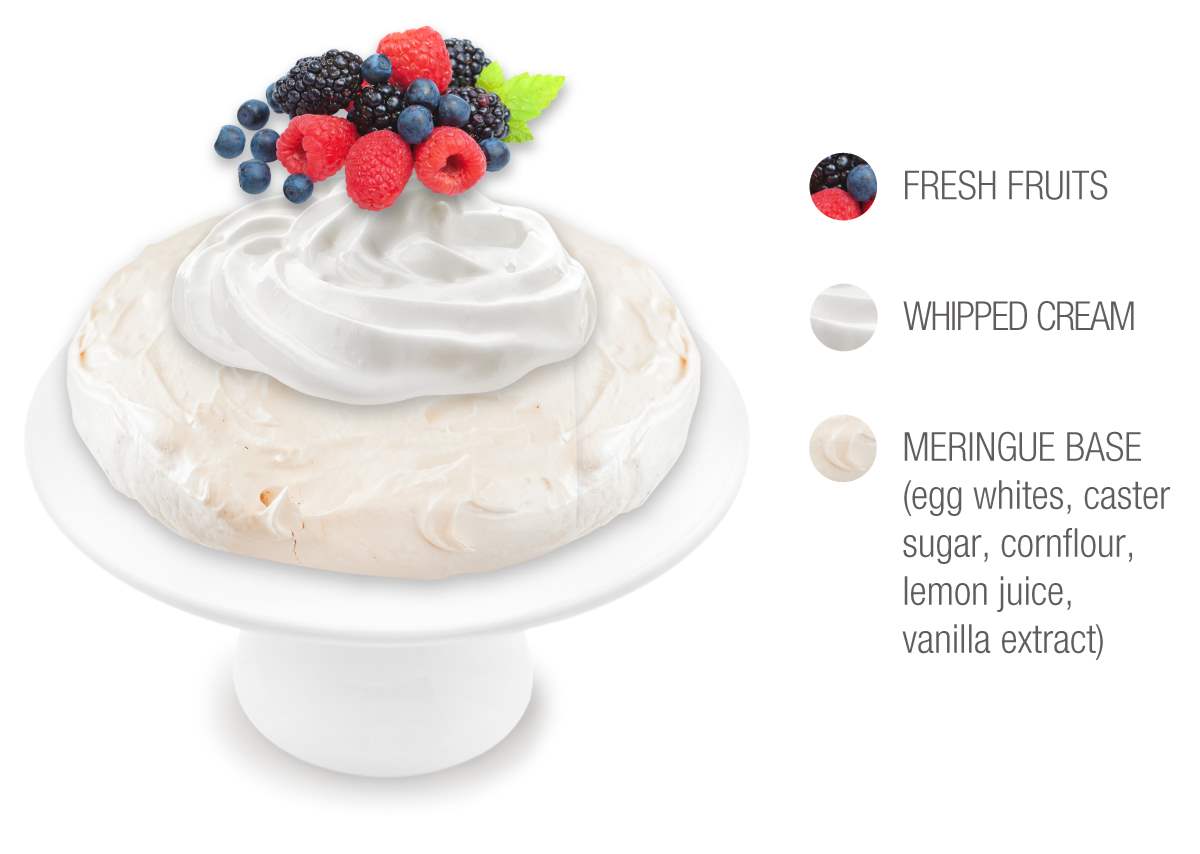
INTRODUCTION & HISTORY
Most commonly served in Australia and New Zealand as a part of Christmas dinner and for other festive occasions, pavlova — or the pav, as they tend to call it — requires simple yet fresh and quality ingredients and some skill for its preparation. The base of a pavlova is made with egg whites, caster sugar, cornflour, lemon juice, or other acids (such as vinegar or tartaric acid), and vanilla extract, which are mixed until peaks are formed. It is then baked at a low temperature to become crunchy on the outside and marshmallow-like on the inside and carefully cooled in a turned-off oven, with the door ajar. It is essential that the base of a pavlova does not get in touch with cool air at this point since that may cause it to drop. The dried and cooled base is covered with whipped cream and sliced fruit — the usual combination includes strawberries, bananas, kiwis, and passion fruit.
The origin of this recipe is a subject of a well-known and well-documented dispute between Australia and New Zealand, who both claim that pavlova was their invention. Back in 1926 the ballerina Anna Pavlova paid a visit to Australia and New Zealand. Her elegant dance moves and appearance allegedly inspired both nations to create a meringue, cream, and fruit dessert that bears her name. Anna Pavlova's biographer Keith Money claimed that pavlova cake was created by a New Zealand chef in Wellington in 1926. On the other hand, a culinary anthropologist, Professor Helen Leach from the University of Otago, New Zealand, published a book, The Pavlova Story: A Slice of New Zealand's Culinary History, where she stated that the first Australian pavlova recipe was created in 1935, and an earlier version was published in 1929 in a smaller New Zealand magazine. Finally, Dr. Andrew Paul Wood and Ms. Anabelle Utrecht — from New Zealand and Australia, respectfully — took a two-year-long research on the subject, concluded by a book and a documentary Pavlova: A Cake and its Secret History, which showed that pavlova was initially called the Spanische Windtorte during the Austrian Habsburgs era in the 18th century. It was then transferred to the United States, and the earliest documented recipe for pavlova dates to 1911 when it was published in the New Zealand Herald newspaper.
Most commonly served in Australia and New Zealand as a part of Christmas dinner and for other festive occasions, pavlova — or the pav, as they tend to call it — requires simple yet fresh and quality ingredients and some skill for its preparation. The base of a pavlova is made with egg whites, caster sugar, cornflour, lemon juice, or other acids (such as vinegar or tartaric acid), and vanilla extract, which are mixed until peaks are formed. It is then baked at a low temperature to become crunchy on the outside and marshmallow-like on the inside and carefully cooled in a turned-off oven, with the door ajar. It is essential that the base of a pavlova does not get in touch with cool air at this point since that may cause it to drop. The dried and cooled base is covered with whipped cream and sliced fruit — the usual combination includes strawberries, bananas, kiwis, and passion fruit.
The origin of this recipe is a subject of a well-known and well-documented dispute between Australia and New Zealand, who both claim that pavlova was their invention. Back in 1926 the ballerina Anna Pavlova paid a visit to Australia and New Zealand. Her elegant dance moves and appearance allegedly inspired both nations to create a meringue, cream, and fruit dessert that bears her name. Anna Pavlova's biographer Keith Money claimed that pavlova cake was created by a New Zealand chef in Wellington in 1926. On the other hand, a culinary anthropologist, Professor Helen Leach from the University of Otago, New Zealand, published a book, The Pavlova Story: A Slice of New Zealand's Culinary History, where she stated that the first Australian pavlova recipe was created in 1935, and an earlier version was published in 1929 in a smaller New Zealand magazine. Finally, Dr. Andrew Paul Wood and Ms. Anabelle Utrecht — from New Zealand and Australia, respectfully — took a two-year-long research on the subject, concluded by a book and a documentary Pavlova: A Cake and its Secret History, which showed that pavlova was initially called the Spanische Windtorte during the Austrian Habsburgs era in the 18th century. It was then transferred to the United States, and the earliest documented recipe for pavlova dates to 1911 when it was published in the New Zealand Herald newspaper.
MAIN INGREDIENTS

RECIPE VARIATIONS

- 4.5
Classic Pavlova
READY IN 6 hThis is one of the oldest published recipes for pavlova, dated 1935 in the Tasmanian newspaper Advocate. The lemon juice from newer versions is here replaced with vinegar under the same intention — to prevent the meringue from getting a yellowish hue. This version is envisioned to resemble a sandwich — the cream and fruit are placed between two crunchy meringue layers. Additionally, in this recipe you can enrich the inside of a pavlova with a marshmallow filling.
Authentic recipe
Ingredients
8 servings- 6 egg whites10 tbsp sugar2 tsp vinegar1 tsp vanilla essencewhipped cream flavored with few drops of vanillafresh fruit (peaches, strawberries, lemon, passion fruit), finely choppedOPTIONAL - MARSHMALLOW FILLING1 lb (450g) granulated sugar1 ½ cups (360 ml) of water1 oz (30g) powdered gelatine½ tsp tartaric acid2 egg whitesvanilla essence
Preparation
- Step 1/3Beat the egg whites very stiff, then gently add sugar, vinegar, and vanilla essence. Line two shallow sandwich tins with greased paper and place half of the mixture into each. Smooth out the top of each and sprinkle some fine sugar on top. Leave it to rest for two minutes, place in a moderate oven (remark: later versions suggest 250 to 300°F/120 to 150°C, but this version does not state the exact temperature), and bake lightly, so it remains white.Step 2/3When cooled, cover the first base with a thick layer of whipped cream flavored with a few drops of vanilla extract. Sprinkle with finely chopped fresh fruit and/or additional filling such as marshmallow or passion fruit. Cover with another layer of whipped cream, and gently place the second base on top. Decorate as desired.Step 3/3Optionally, you can enrich the inner layer with marshmallow filling. To prepare the filling, soak the gelatine in ½ cup (120 ml) of water, and boil the sugar and the rest of the water (1 cup/240 ml). The consistency is right when the mixture forms a soft ball when dropped in cold water. Add the gelatine and the acid and boil for a few minutes. Cool the mixture down, and meanwhile, beat the egg whites with the vanilla essence. Add the egg white mixture to the gelatine and beat again. Pour into a sandwich tin and place on pavlova when fully set.
Cooking Tips
EGGS
For pavlova to succeed, it is essential to have fresh eggs. Since only the egg whites are used, you can freeze the yolks or use them for another dish. Alternative vegan versions suggest you can replace the egg whites with water from canned chickpeas.SUGAR
Most recipes prefer superfine sugar, as it will not fall heavily on the mixed egg whites.CREAM
A classic, full-fat cream is best to use for pavlova because light versions might not set properly. Since the meringue is sweet enough, it is not recommended to add sugar to the cream.FRUIT
Choose ripe, fresh fruit and make sure it is dry before you place it on top of pavlova.TECHNIQUE
When preparing the meringue base for pavlova, the most important thing is not to let a single drop of egg yolk get into the egg whites, since you will not be able to reach the desired consistency. When adding sugar to the egg whites, it is advised to do it spoon by spoon and combining it gently, so the air does not get out. It is necessary to use the greased paper when baking the meringue. You can fix it to the baking pan by simply putting four drops of meringue under each of the four corners of the paper. Bake the meringue at a low temperature. You can cool it in the turned-off oven with the door ajar, but do not allow it to get in touch with cool air since it will cause the meringue to drop. You can prepare the meringue a day before serving, but add cream and fruit at the last moment. Doing it earlier might make pavlova soggy and without crunchiness. You can make smaller, portion-sized meringue bases and allow your guests to pick their own pavlova topping.
This is one of the oldest published recipes for pavlova, dated 1935 in the Tasmanian newspaper Advocate. The lemon juice from newer versions is here replaced with vinegar under the same intention — to prevent the meringue from getting a yellowish hue. This version is envisioned to resemble a sandwich — the cream and fruit are placed between two crunchy meringue layers. Additionally, in this recipe you can enrich the inside of a pavlova with a marshmallow fillim
INTRODUCTION & HISTORY
Most commonly served in Australia and New Zealand as a part of Christmas dinner and for other festive occasions, pavlova — or the pav, as they tend to call it — requires simple yet fresh and quality ingredients and some skill for its preparation. The base of a pavlova is made with egg whites, caster sugar, cornflour, lemon juice, or other acids (such as vinegar or tartaric acid), and vanilla extract, which are mixed until peaks are formed. It is then baked at a low temperature to become crunchy on the outside and marshmallow-like on the inside and carefully cooled in a turned-off oven, with the door ajar. It is essential that the base of a pavlova does not get in touch with cool air at this point since that may cause it to drop. The dried and cooled base is covered with whipped cream and sliced fruit — the usual combination includes strawberries, bananas, kiwis, and passion fruit.
The origin of this recipe is a subject of a well-known and well-documented dispute between Australia and New Zealand, who both claim that pavlova was their invention. Back in 1926 the ballerina Anna Pavlova paid a visit to Australia and New Zealand. Her elegant dance moves and appearance allegedly inspired both nations to create a meringue, cream, and fruit dessert that bears her name. Anna Pavlova's biographer Keith Money claimed that pavlova cake was created by a New Zealand chef in Wellington in 1926. On the other hand, a culinary anthropologist, Professor Helen Leach from the University of Otago, New Zealand, published a book, The Pavlova Story: A Slice of New Zealand's Culinary History, where she stated that the first Australian pavlova recipe was created in 1935, and an earlier version was published in 1929 in a smaller New Zealand magazine. Finally, Dr. Andrew Paul Wood and Ms. Anabelle Utrecht — from New Zealand and Australia, respectfully — took a two-year-long research on the subject, concluded by a book and a documentary Pavlova: A Cake and its Secret History, which showed that pavlova was initially called the Spanische Windtorte during the Austrian Habsburgs era in the 18th century. It was then transferred to the United States, and the earliest documented recipe for pavlova dates to 1911 when it was published in the New Zealand Herald newspaper.
MAIN INGREDIENTS
WHERE TO EATThe best Pavlovain the world(according to food experts)
Bennelong
"The thing is, it isn’t overly sweet, and as such doesn’t overpower. While there’s a lot of really pillowy meringue cream, I felt that I could go through a fair few spoonfuls before sugar overload. It’s really quite nice."
Rockpool Bar & Grill
"Australia's most successful restaurateur, Neil Perry, rules here with big steaks, gutsy shiraz, and of course, passion-fruit pavlova."
Cibo
"We also got a delicious but preposterously sized pavlova, enough for a table of four and perfect to box up for the babysitter."
Hopetoun Tea Rooms
"We had a slice of pavlova and vanilla slice and they were perfection."
Chokolait Hub
"With a crisp crust and soft filling, it is one of the most popular dishes in Australia and a must try when you are here. Where to Try: Chokolait Hub."
Public Kitchen and Bar
"When it comes to desserts, be warned that Public’s servings are extra-large. Not that anyone would complain about 1kg of crème brulee and pavlova, especially when they’re this good."
Winona Forever
"The striking summer colours of this dish certainly brightened up my morning and it is definitely a good way to start the day. Part breakfast and part dessert, the pavlova is a must-try here in New Zealand that should be on your list, and this tangy twist left an everlasting impression on me!"
Floriditas
"For my pav I turned to Floriditas Morning Noon & Night, the cook book from my favourite cafe & where they just happen to make the most delectable brown sugar pavlovas."
Mikano Seafood Restaurant
"Soft pavlova roulade with passionfruit cream & tropical fruit salad. We love this a lot!"
Batch Winery
"You must save room for the top tier, which is the signature dish: smashed pavlova - oozing yoghurt-laced whipped cream and seasonal fruit compote."



